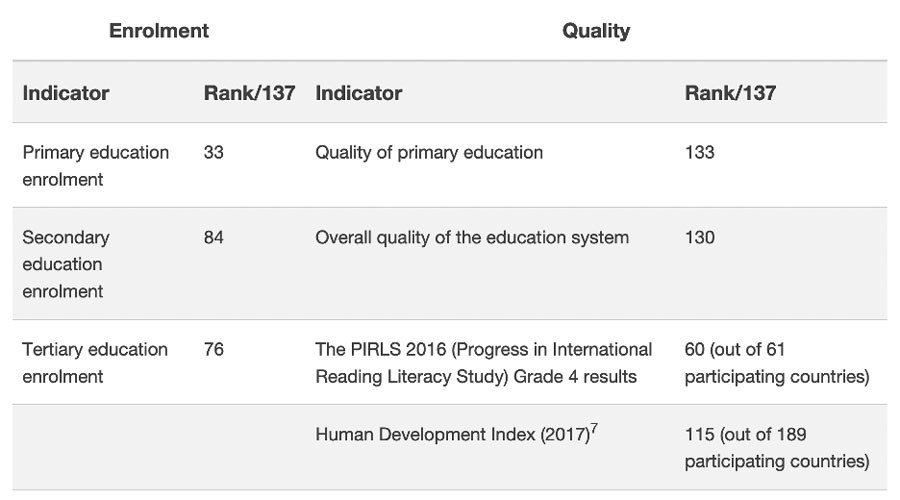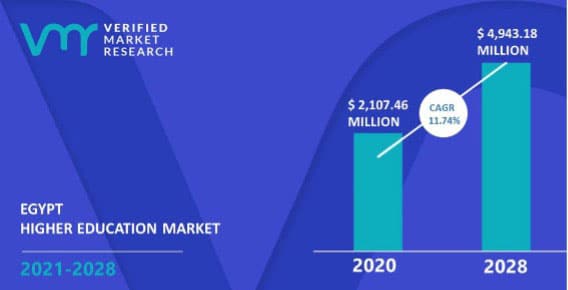A primer on international student recruitment in Egypt
- The number of Egyptian students going abroad for higher education has nearly tripled in the past decade
- Burgeoning demand for higher education has Egypt poised to be an important growth market for student recruitment in the decade ahead
- Egypt is the most populous country in the Arab world (107 million), and it is expected to add millions more by 2030
As destinations expand the number of countries and regions in which they recruit, there is a real need to understand the nuances of each emerging market’s economy, culture, challenges, and potential. Egypt is a new source market for many educators, and so we’re focusing attention today on information to help illuminate the context in which Egyptians consider study abroad.
Most fundamentally, it is crucial that foreign universities and colleges have a thorough plan not just for enrolling Egyptian students, but also for ensuring that students are well prepared for success in programmes taught in English, French, German, Japanese, or other languages. Language schools have an important role to play in this regard. English proficiency rates are low in Egypt.
Fast facts
Geography: Northeast Africa, bordering Israel, Palestinian territories (Gaza strip), Libya, and Sudan.
Population: 107 million. An interesting exercise is to compare that to the populations of other increasingly prioritised student markets, for example Turkey (82,000) Thailand (70,000), Ghana (32,000), Nepal (30,000), and Sri Lanka (22 million).
Official language: Arabic. English and French are widely understood by well-educated segments of the population.
Language of instruction: Arabic in public schools, with instruction in other languages available at some private schools and at international schools.
Religion: 90% Muslim, rest mostly Christian.
Main cities: Cairo, Alexandria, Giza, Port Said, Suez.
Economy: Egypt’s economy grew by 6.6% in FY2021/22, double the growth of the previous year, but the war in Ukraine and related commodity price shocks are dampening this trend. Egypt’s currency fell to record lows against the US dollar in November 2022 and inflation is hovering around 15%. The Egyptian military exerts tremendous control over the economy, and many argue that this is a barrier to the country’s private sector development and the economy’s diversification. Overall, agriculture, media, petroleum imports, natural gas, and tourism are the top sectors, and China, the US, and Saudi Arabia are the top trade partners.
Currency: Egyptian Pounds (EGP).
Opportunities abound
The potential for Egyptian outbound to grow dramatically is huge, not the least because of Egypt’s expanding population and youth demographic. Egypt is the most populous country in the Arab world (107 million), and it is expected to add millions more by 2030. This will represent the largest population increase in the MENA region. Almost 20% of Egyptians are aged 15–24, and a quarter of them are unemployed. Of those who are unemployed, 36% hold tertiary degrees.
The number of Egyptian students going abroad for higher education has nearly tripled in the past decade, from 12,300 in 2008 to more than 43,700 as of the last UNESCO count.
According to UNESCO, Egypt is the fourth largest sender of international students in the Middle East after Saudi Arabia, Morocco, and Syria.
Reflecting strong academic, immigration, and commercial ties within the region, roughly a third of Egypt’s outbound students choose to study in UAE (5,260) or Saudi Arabia (4,890). In addition, close to 4,000 Egyptians are studying in the US, and between 2,000–3,000 are studying in Canada, the UK, France, Germany, and Malaysia. Most of those countries enrolled record numbers of Egyptians in the past two years.
Egypt currently has over 20 public universities (enrolling 74% of Egyptian tertiary students) and over 20 private universities. To accommodate more students, the government has lately embraced international branch campuses (IBCs). However, given Egypt’s massive youth population, even a significant expansion of the domestic higher education sector and of IBCs will not accommodate enough students, and so demand for study abroad is likely to grow.
Where the students are: K-12
Egypt has the largest K-12 student population in the MENA region: 23 million students in 2020, 20% of whom are in Greater Cairo. The US International Trade Administration reports that “Egypt’s private sector K-12 student growth has almost doubled in the last five years.”
Colliers International says that:
“The most popular curriculum among the top private schools in Greater Cairo is the British system, followed by American, IB and Canadian curriculums. However almost 35% of these schools offer more than one curriculum.”
According to El Alsson British and American Schools director Karim Rogers, Egyptian high school students are becoming more attracted to European destinations such as the Netherlands, Belgium, and Spain. Asian destinations – especially Malaysia – are also in high demand because they are more affordable than the US or UK, according to Noor El Mahallawi, founder of the IG Club, a platform that helps students prepare for English-language university programmes.
Recruiters may find private schools offer an interesting opportunity. While these schools hold a small share of the overall K-12 market (10.6% in 2019/2020), Colliers International reports that:
“Enrolment at private schools has grown at a CAGR of 6.3% compared to 3.6% CAGR in public schools, thus indicating a preference for private education amongst parents in the country. Supply of private schools has also grown at 4.4% CAGR between 2014-15 and 2018-19, which is more than double the rate of growth in public schools, which indicates increasing investor interest in the sector.”
International schools will enrol some of the most suitable candidates for study abroad given their foreign curriculum. This is a list of international schools in Egypt: https://www.expatarrivals.com/africa/egypt/international-schools-egypt
Where the students are: university level
There are currently 3.6 million students at public and private universities in Egypt, representing a major opportunity for foreign educators offering post-graduate programmes. Demand for undergraduate programmes and for graduate programmes tends to be balanced, but in recent years, post-graduate programmes have become more popular. For example, the number of Egyptians pursuing post-graduate programmes in the US has risen by 26% over the past decade.
According to multiple experts who specialise in study abroad for Egyptian students, applications for overseas institutions did not slow down even during the pandemic, and nor did the applications for scholarship programmes.
Nevine Sharaf, programme manager for the UK government-sponsored Chevening scholarship, told online Egyptian news site Enterprise in April 2022 that,
“[We] didn’t see a change in the number of applications from Egypt [during the pandemic]. The scholarship program’s most recent round saw somewhere between 2.8K-3K applications from Egypt, which is on par with the annual average.”
A list of international scholarships for Egyptian students can be found here and here.
These are the top seven universities in Egypt as determined by QS:
- American University in Cairo (in the top 500 in the global ranking and in the top 20 in the Arab Region) - private
- Cairo University (just outside of the top 500 in the global ranking and in the top 20 in the Arab Region) - public
- Ain Shams University (in the top 1,000 in the global ranking and in the top 20 in the Arab Region) - public
- Alexandria University (in the top 1,000 in the global ranking and in the top 20 in the Arab Region) - public
- Mansoura University (28th in the Arab Region) - public
- Assiut University (in the top 50 Arab Region) - public
- Helwan University (in the top 50 in the Arab Region) – public
More universities can be explored at UniversitiesinEgypt.com.
Market limitations and important considerations
A PWC report points to a major tension in the current state of Egyptian educational progress. On the one hand, primary and secondary enrolment rates are very respectable compared with the global average. However, the quality of education that millions of students are receiving is poor.

Foreign educators need to be prepared to offer Egyptians plenty of academic and language support and a foundation year may well be necessary for many students. Egyptian students have consistently lagged at least a year behind students from other parts of the world. UNESCO has determined that, “More than half of Egyptian students don’t meet the benchmark in international learning assessments.”
Speaking with The Arab Weekly, Stefan Trines, research editor at the World Education Services, explained that in Egypt:
“Children from more affluent households may be able to circumvent problems in the public-school system by enrolling in private schools or compensating with private tutoring. Those who can attend private schools, which have more autonomy and better facilities, are more qualified and are in an advantageous position to meet the demands of the job market compared to the students from the lower classes. Research has shown that youths from the highest wealth quintile in urban areas are more than nine times more likely to gain access to higher education than youths from the lowest wealth quintile in rural Egypt.
Keys to the market
Every Egyptian student considering their future – and study abroad – will be highly aware that good job opportunities are currently very limited in their country, except for students from the wealthiest and/or most connected families. They will therefore be highly interested in programmes with a clear link to in-demand jobs in the wider global economy.
In 2016, one Egyptian student told The Atlantic Council (a US thinktank devoted to US policies around global engagement that: “An ‘invisible wall’ separates the people from the decision-makers, and for youth it’s impossible to break through that wall. Ministers, managers, people in high positions, are old men without vision for the future … there are no youth in leadership positions.”
Mohamed al-Saadani, a political science professor at Alexandria University, told the Arab News in 2018 that, “Most of [Egyptian youth] who leave or want to leave are after high-paying jobs, better living conditions and a better future for their children — things they will not achieve by staying.”
Families may need substantial guidance when choosing foreign university programmes, as there is a long tradition in Egypt in which securing a government job (and lifelong career) has been the ultimate goal, much more so than aspirations for a job in a private sector or for an entrepreneurial career path.
Post-study work rights will obviously be a major draw for prospective Egyptian students given high demand for emigration, so educators that can leverage these opportunities should definitely do so – and involve career counsellors and successful Egyptian alumni in their webinars and other outreach.
An informative guide to market entry strategies for Egypt, including digital strategies and considerations, is here at Istizada. Highlights include:
- Egypt is the top Middle Eastern country for Facebook penetration;
- Twitter is also widely used, with Egyptians responsible for 17% of all tweets in MENA – only Saudi Arabians tweeted more;
- Top regional websites geared at Middle Eastern, Arabic-language users are: Youm7.com, Google.com.eg, Yallakora.com, Almasryalyoum.com, Filgoal.com, Elbalad.news, Masrawy.com, Cima4u.ws, Iegybest.co, Elwatannews.com;
- Egyptians make more search queries than people in any other MENA country except Saudi Arabia, and are just behind Saudi Arabians in how much they stream YouTube videos;
- Over 60% of Egyptians prefer websites in Arabic and also like local content, including blogs;
- Fashion is the most viewed local content (52%), with technology next at 31%.
Market projection for Egypt: See chart below.

For additional background, please see:


















